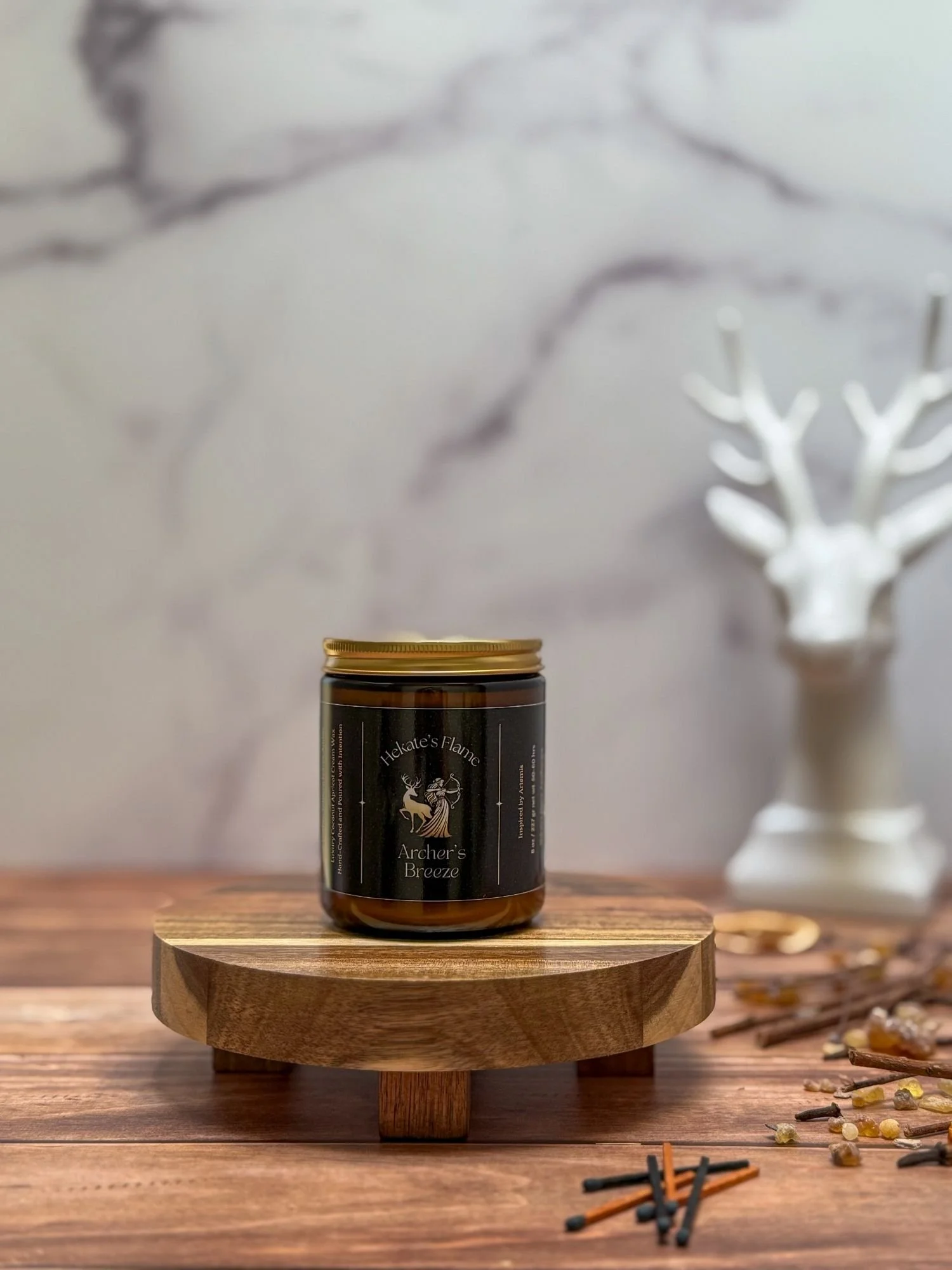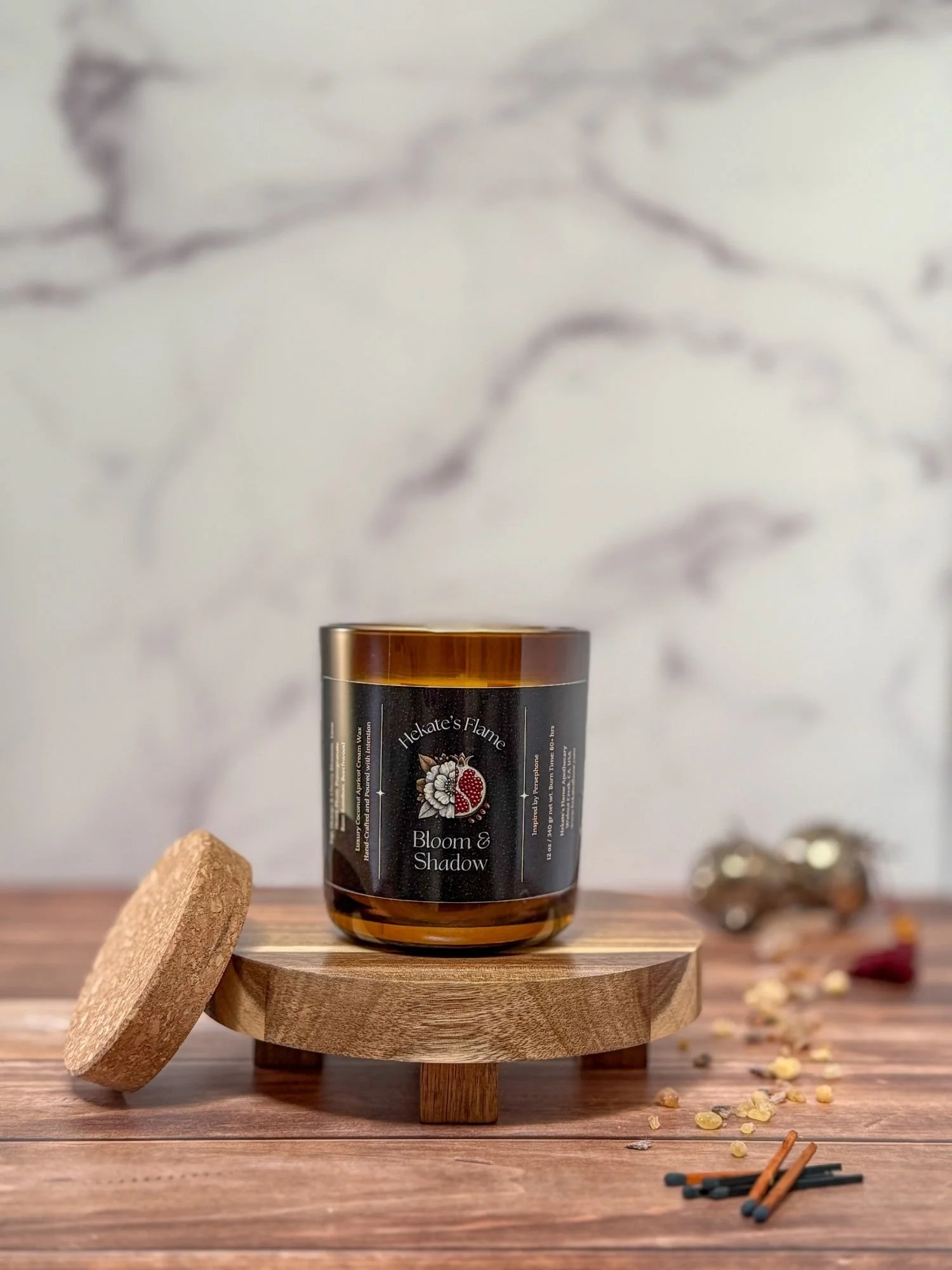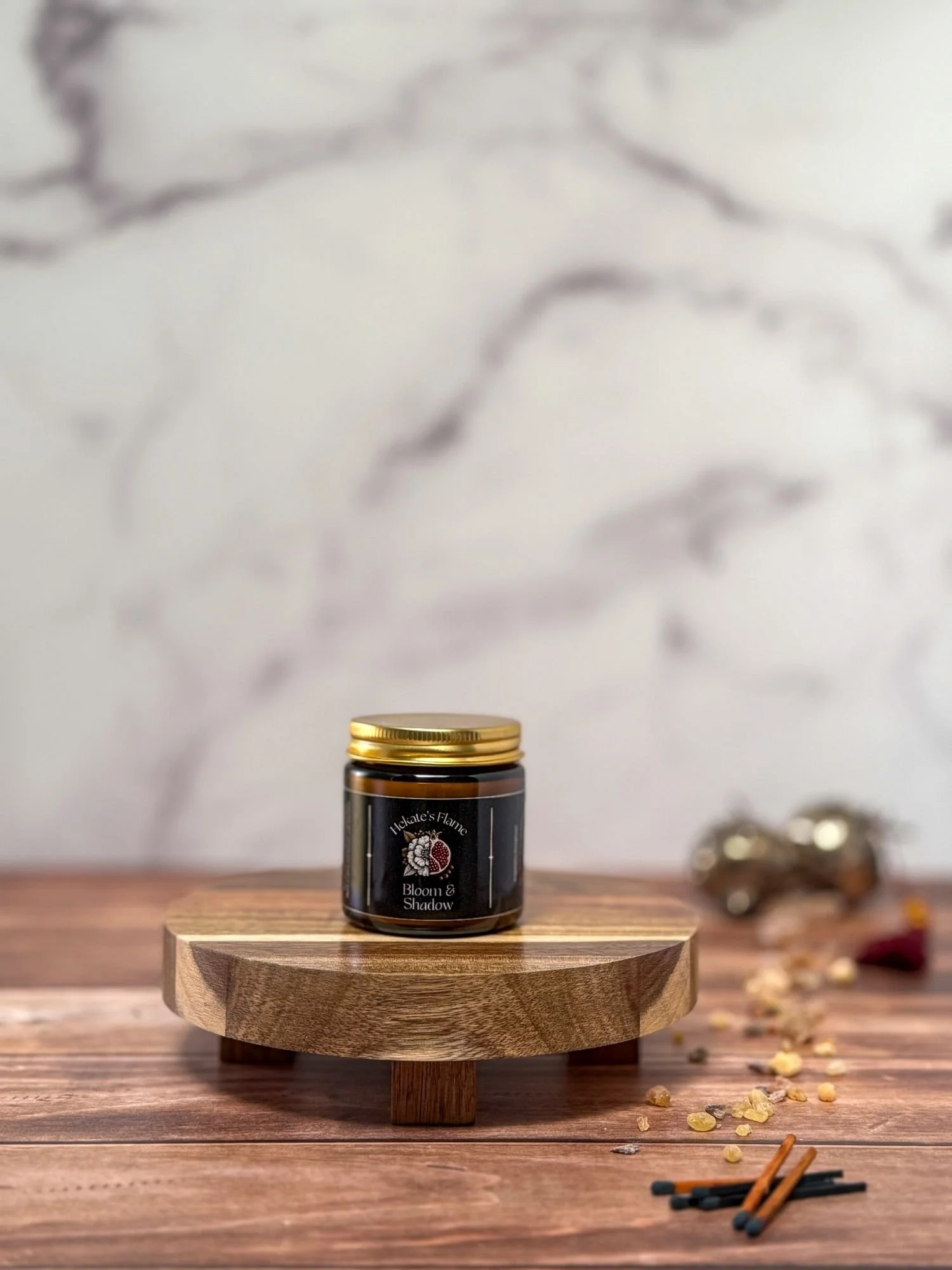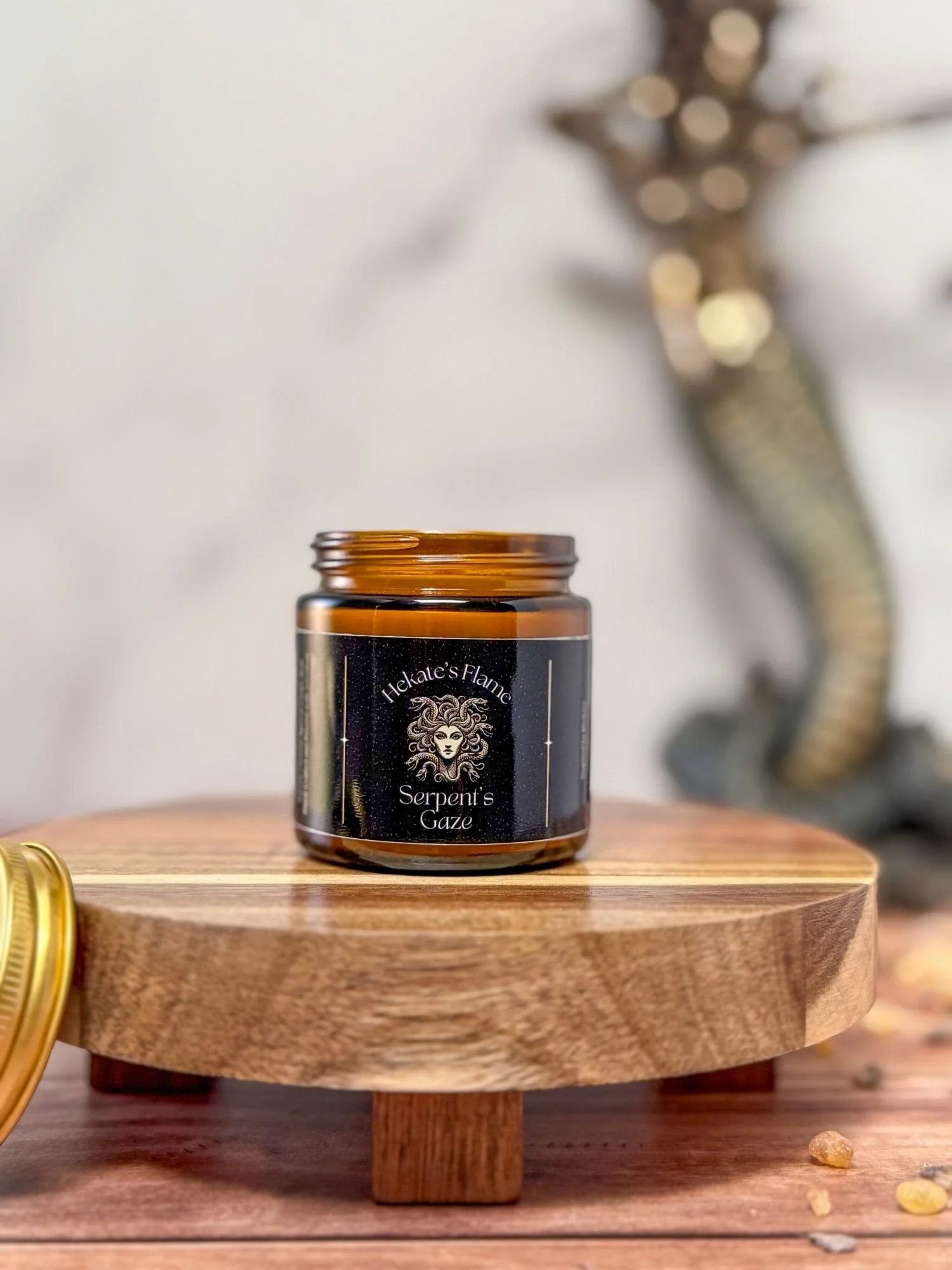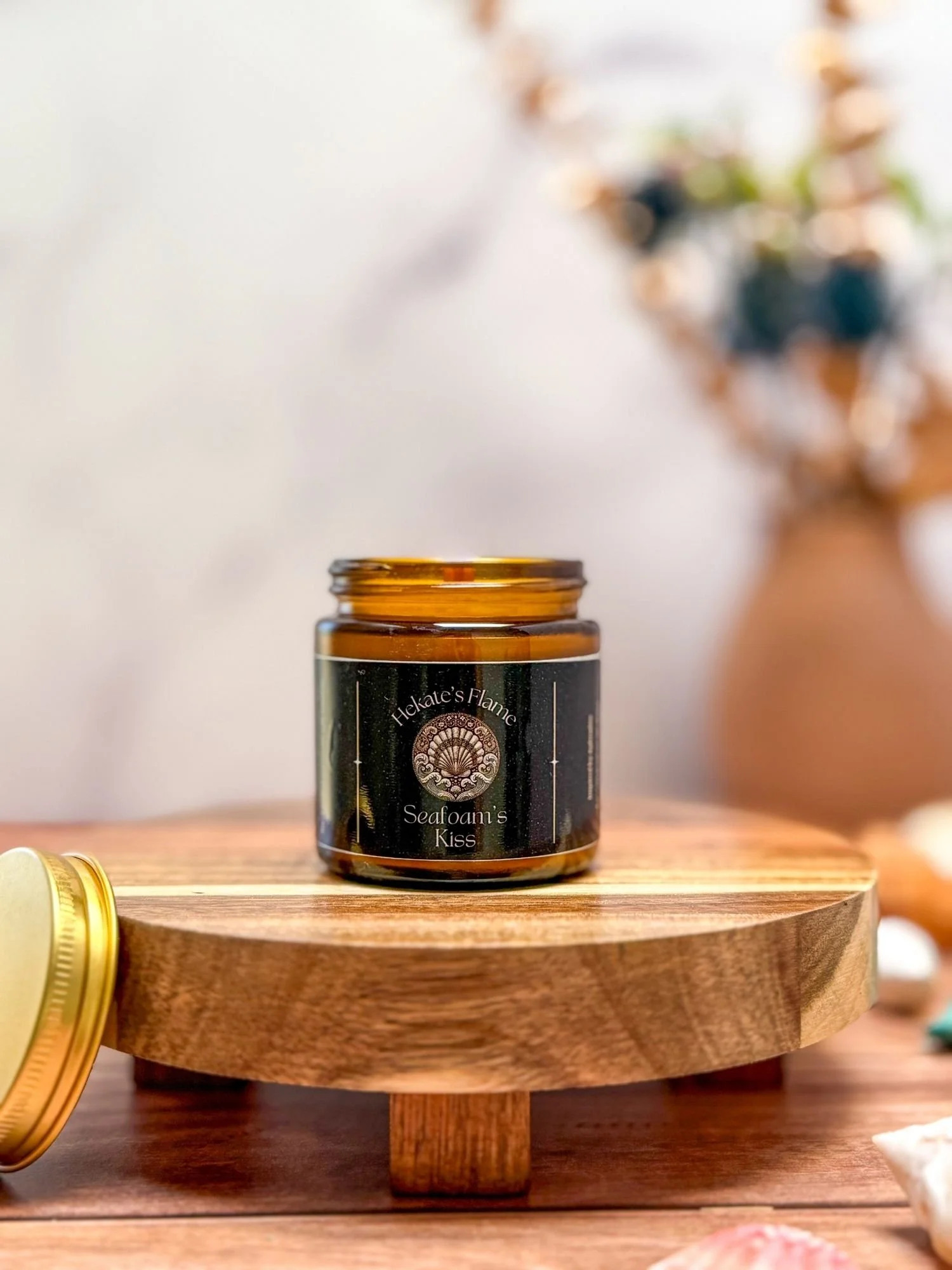‘Regal Rose’: a handmade artisanal candle inspired by Hera, the Greek goddess of marriage, the sky and heavens, and queen of the gods
She who watches with a thousand eyes and reigns with grace and fury
Imagine a throne bathed in morning light, petals and storm clouds gathering at its feet. That is the essence of Regal Rose: basil and grapefruit bright and commanding, rose and magnolia unfolding in regal grace, and patchouli grounding it in calm, unshaken strength. A scent of elegance and authority, honoring Hera, whose love and fury alike remind us that power can wear the scent of devotion to what we hold most sacred.
Scent Notes:
Top: Basil, Grapefruit
Heart: Rose, Magnolia
Base: Patchouli
🌹 Season Scent: Spring
🌸 Primary Scent Family: Floral
🌿 Secondary Scent Family: Aromatic & Herbal
Please visit this blog post for more information on Scent Profiles, Top, Heart, and Base Notes.
Our candles are lovingly handcrafted in our home studio, Nimue’s Lair, nestled in Walnut Creek, CA. Each one begins with a luxurious blend of coconut-apricot wax, carefully infused with premium fragrance oils. Poured by hand into elegant glass vessels and amber jars, they’re finished with hand-cut labels and enchanted final touches. Every candle is a small ritual, infused with magick, intention, and the quiet glow of story.
-
12 oz Deluxe – Amber Aura Glass · Coco Apricot Wax
Burn Time: 60+ hours
Bold and enduring, this candle fills your space with myth and memory. Crafted for spacious sanctuaries, this candle shines in wide-open living rooms, high-ceilinged studios, and sacred hearths ~ places where scent is free to roam and the flame becomes a luminous companion to stillness and story.8 oz Classic – Amber Jar · Coco Apricot Wax
Burn Time: 50–60 hours
A perfect size for quiet corners and thoughtful pauses. Let it warm your reading nook, home office, or bedside altar, where its flame flickers like a whisper of intention.4 oz Petite – Amber Jar · Coco Apricot Wax
Burn Time: 20–25 hours
Small in size, rich in presence. This candle is ideal for travel, gifting, or sanctifying intimate spaces - guest rooms, personal altars, or quiet corners where scent and flame are invited to linger with intention. -
For detailed information about our waxes, wicks, fragrance blends, and vessels, please see our Ingredients & Materials Guide.
-
For guidance on how to tend your flame with care, ensuring the cleanest, safest, and most enchanting burn, please visit our Candle Care Guide.
-
Please visit the Shipping and Returns Information page for details.
-
All photographs, images, and written content on this website are original works of Hekate's Torch Apothecary, LLC (doing business as Hekate’s Flame Apothecary) and are protected by copyright. They may not be used, altered, shared, or reposted on any platform without explicit written consent. All label designs, photos, images, and content are the exclusive property of Hekate's Torch Apothecary, LLC.
For inquiries regarding the use of our content, please contact: care@hekatesflame.com
© 2025 Hekate's Torch Apothecary, LLC. All rights reserved.
Content Warning:
This post explores ancient myths that include themes of violence, including assault and warfare, which may be sensitive for some readers. Please proceed with care and be mindful of your well-being while engaging with these stories.
Photo images from Unsplash.
Reclaiming Hera: The Queen of Olympus in the Context of Patriarchy and Power
In Greek mythology, Hera often stands out as one of the most complex and misunderstood figures among the Olympian gods. Commonly remembered for her jealousy, vengefulness, and wrath, Hera is frequently portrayed as the long-suffering wife of Zeus, perpetually enraged by his numerous affairs and taking revenge on the women he seduced and their offspring. However, when we examine her mythology through the lens of ancient Greek society, especially its patriarchal structure, it becomes clear that there's much more to Hera than the traditional depictions of a scorned, vindictive wife. In this post, we'll explore Hera's mythology, not to whitewash her actions but to better understand her character and role in the broader context of Greek patriarchal norms.
Hera as the Great Mother Goddess: From Matriarchal Power to Patriarchal Domestication
Hera was no mere consort to Zeus in the original pantheon of Greek deities. In fact, her origins predate her marriage to Zeus, and she was initially worshipped as a powerful goddess in her own right. Archaeological evidence and mythological studies suggest that Hera was a Great Mother Goddess of pre-Hellenic Greece, deeply associated with fertility cycles, the earth, and women's lives.
The three stages of womanhood, maiden, mature woman, and elder, were reflected in Hera's own phases as Hebe (youth), Teleia (the mature woman), and Theira (the elder or solitary woman), roles that aligned with the rhythms of the earth and seasons.
This early depiction of Hera paints a picture of a deity who held immense power over life, death, and rebirth, symbolized by her sacred animals, including the cow, peacock, and cuckoo bird. Her worship was centered at Argos and Samos, where significant temples and shrines were dedicated to her. In her earlier forms, Hera was a deity connected to the earth's abundance, the fecundity of nature, and the sacred rites of women, especially in relation to childbirth and marriage. She was also a protector of women and could be invoked in rituals for purification and healing, highlighting her role as a guardian of both the physical and emotional realms.
The fact that Hera was initially worshipped independently, without the influence of Zeus, is crucial in understanding her later mythology. When the Indo-European tribes invaded and overlaid their own pantheon of gods onto the indigenous deities of Greece, Hera's narrative was co-opted into the patriarchal order. As patriarchal values took root in Greek society, Hera's powerful, autonomous identity was subordinated to that of Zeus, the new supreme ruler of the gods. No longer the autonomous deity of fertility, she was domesticated and redefined as the goddess of marriage, reflecting the new cultural emphasis on women's roles as wives and mothers, subordinate to male authority. This shift drastically altered Hera's role in mythology, reconfiguring her as Zeus's wife, a role in which her autonomy and power were consistently challenged.
Hera's Sacred Animals: Symbols of Fertility, Power, and Marriage in Greek Mythology
Whatever it is, the way youHera's sacred animals, the peacock, cow, and cuckoo bird, were prominent symbols of her divine authority long before her union with Zeus. The cow, symbolizing fertility and abundance, highlighted her role as the Great Mother Goddess of pre-Hellenic Greece. At the same time, the peacock became a representation of her regal beauty and power. Her association with the cuckoo bird would later become part of the myth of her marriage, cementing her ties to the cycles of life and the sanctity of marriage.
Hera's Temples and Festivals: Celebrating the Goddess's Power and Influence in Ancient Greece
Hera's divine authority was reflected in the grand sanctuaries and temples dedicated to her across Greece. The Heraion at Olympia, which predated the temple of Zeus, is a testament to her early importance. Her sanctuary at Argos was one of the most significant centers of worship, where the Heraia athletic races were held every four years to honor the goddess. These races, dedicated to Hera, were some of the earliest known festivals celebrating the achievements and strength of women. tell your story online can make all the difference.
Hera's Divine Connections: Her Role Among the Goddesses and the Seasons
Hera's connections to other goddesses reveal her integral role in the Olympian pantheon, especially her relationship with goddesses such as Metis, Mnemosyne, and Leto, each of whom played critical roles in Zeus's life and the birth of key Olympian deities.
Hera's rivalry with Leto, the mother of Apollo and Artemis, underscores her fierce defense of marriage, while her interactions with Metis, the mother of Athena, speak to her knowledge of Zeus's complex relationships and the power dynamics within Olympus.
Hera also shared a close connection with the Horae, the goddesses of the seasons, whose name is derived from the same root as her own. These seasonal goddesses represent the natural cycles of time, aligning with Hera's role as a deity who embodies the stages of life. As such, Hera not only governed the sanctity of marriage but also presided over the cosmic order, linking her divine authority to the progression of life and the changing seasons.
Sacred Offerings and Rituals: Honoring Hera in Ancient Greek Worship
Hera was deeply revered in ancient Greek worship, and specific rituals and offerings were integral to maintaining her favor. Devotees honored the goddess with sacred offerings of honey, flowers, incense, perfume, and pomegranates, symbolizing fertility, abundance, and devotion. These offerings reflected her role as the goddess of women, marriage, and childbirth, reinforcing the importance of seeking her protection and guidance in these domains.
One of the most significant rituals dedicated to Hera took place on the island of Samos, where the famous 'roping' ritual was performed. This ritual involved tying Hera's statue to a tree, symbolizing her 'binding' in marriage to Zeus. It reflected Hera's connection to the natural world and the patriarchal system that redefined her role as Zeus's wife. These rituals, rich in symbolism, show how Hera was revered for her power and as a guardian of life's most sacred institutions.
Hera and Zeus: The Mythology Behind Their Marriage in a Patriarchal World
The union between Hera and Zeus is often framed as a foundational aspect of Greek mythological hierarchy, but its origins tell a story of domination rather than partnership. According to myth, Zeus tricked Hera into marrying him by transforming into a cuckoo bird, caught in a storm. Feeling pity for the bedraggled bird, Hera held it close to her chest, at which point Zeus revealed his true form and forced himself upon her. Shamed by the violation, Hera agreed to marry Zeus to restore her honor, marking the beginning of one of mythology's most famously turbulent marriages.
This act of trickery and coercion is emblematic of a larger pattern in Greek mythology where male gods assert their dominance through deceit or outright violence. Hera's marriage to Zeus was not a union of equals but a relationship forged through patriarchal control. While Hera retained her position as the queen of Olympus, her autonomy was significantly compromised, as evidenced by Zeus's incessant affairs and her forced participation in a system that placed her in a subservient role to her husband.
The myth of Hera's marriage reflects not only her loss of agency but also a broader cultural shift where women, once revered for their connection to life and fertility, were increasingly defined in relation to male power.
In patriarchal Greek society, marriage was a key institution through which women's autonomy was curtailed, and Hera's experience as the goddess of marriage mirrored this reality. The rituals surrounding her worship, such as her annual bathing in the spring Kanathos to renew her virginity, can be seen as symbolic efforts to maintain purity and honor within a societal framework that often undermined women's dignity.
The Jealousy of Hera: Exploring Her Wrath and Vengeance Through a Cultural Lens
Zeus's notorious affairs were a constant source of conflict in his marriage with Hera. To seduce women, Zeus often transformed into various forms, appearing as a swan to seduce Leda, as a bull for Europa, and even as a shower of gold to reach Danae. Each affair was a betrayal of the sacred institution of marriage, over which Hera presided as goddess. Hera's vigilance in monitoring and attempting to thwart Zeus's seductions was not merely an act of jealousy but a defense of her divine authority. Her actions reflect a symbolic struggle between fidelity and betrayal, as she sought to maintain order in a relationship constantly undermined by Zeus's infidelity. Her response was not just emotional. Hera wielded her wrath strategically, using her influence over gods and mortals to assert her power. Though often directed at the women involved, who, though frequently innocent, represented an affront to Hera's dignity, her wrath ultimately reinforced her divine status.
Hera's anger was more than jealousy; it was a direct response to the repeated violations of the sacred domain she ruled. In ancient Greece, marriage was considered a vital institution, and Zeus's affairs were not just personal betrayals but public challenges to Hera's divine authority. As the goddess responsible for upholding the sanctity of marriage, Hera's vengeance expressed her desire to restore order in a system that constantly undermined her position.
Her wrath can also be understood as a reflection of the societal pressures placed on women in ancient Greece, where fidelity and childbirth were integral to a woman's social value. Women's roles were largely defined by their ability to maintain family honor and secure legitimate heirs. As the goddess of marriage and childbirth, Hera's actions can be seen as a personal response to Zeus's infidelity and a broader defense of societal expectations placed on women. Her vengeful pursuit of Zeus's lovers and their offspring not only reinforced her authority but also mirrored the wider cultural norms that demanded loyalty, even in the face of betrayal.
Hera's Influence in the Myths of Heracles and the Trojan War
Hera's influence in mythology goes beyond her marriage to Zeus; she actively shapes the destinies of key figures in Greek myth. Her long-standing feud with Heracles, Zeus's illegitimate son, is a prime example of her wrath. From sending serpents to kill Heracles in his crib to later driving him into madness, causing him to murder his family, Hera's relentless persecution shaped Heracles's journey through the Twelve Labors, which were designed to atone for his sins and ultimately elevate him to godhood. However, Hera's actions were not solely driven by personal grievance; they were an assertion of her power over fate. Heracles, though her enemy, became one of the greatest heroes in Greek mythology partly because Hera made him face immense challenges.
Hera’s role in the Trojan War further reveals the force of her presence in Greek mythology. The conflict was ignited by the golden apple of Eris, inscribed “to the fairest,” which led to a beauty contest judged by Paris. His choice of Aphrodite over Hera and Athena sparked Hera’s wrath and set the stage for her relentless opposition to Troy. Yet her actions were driven by more than wounded pride. Hera was deeply invested in the war’s outcome, using her divine influence to shape mortal destinies and ensure the fall of a city that, to her, embodied the rejection of her authority.
Hera's Rebellion: Power Struggles Within the Olympian Pantheon
Hera's position as queen of the gods was both a privilege and a burden.
While she held significant power in Olympus, her role was constantly challenged by Zeus's actions and the patriarchal structure that elevated male gods above their female counterparts. In several myths, Hera attempts to assert her power, but these efforts are often thwarted or ridiculed, reinforcing her subjugation within the divine order.
One example is Hera's participation in a rebellion against Zeus, which she led alongside Poseidon and Athena. Frustrated by Zeus's tyrannical rule, the conspirators sought to overthrow him, but their rebellion was unsuccessful. They planned to tie Zeus to his bed, but when the rebellion failed, Zeus took brutal revenge on Hera. As punishment, Zeus hung Hera from the heavens with anvils tied to her feet, leaving her to suffer in humiliation. This story illustrates the limits of Hera's power within the Olympian hierarchy and underscores the violent lengths to which Zeus would go to maintain his supremacy.
In many ways, Hera's rebellion reflects the broader tension between the patriarchal order and the remnants of matriarchal traditions in early Greek religion. As a goddess who once reigned independently, Hera's struggle for autonomy within her marriage and within the Olympian order can be seen as symbolic of the larger cultural shift from female-centered religious practices to male-dominated ones. Despite the degradation she endured, her eventual return to Zeus after the rebellion speaks to how even the most powerful female figures in Greek mythology were ultimately forced to conform to patriarchal norms. Yet she remained undeterred in her commitment to justice, marriage, and the protection of her children.
Protector and Punisher: The Dual Role of Hera in Greek Mythology
Hera's role in mythology is often contradictory. On the one hand, she is a protector of women, childbirth, and marriage, a goddess invoked by those seeking guidance and support in these areas. On the other hand, she is frequently depicted as a harsh punisher, unleashing her fury on those who cross her, whether they are mortals, gods, or demigods. This duality reflects the complex nature of her character and the impossible expectations placed on her by the patriarchal system.
As a protector, Hera was deeply involved in the lives of women. She presided over the sacred rites of marriage and childbirth, and her daughter, Eileithyia, was the goddess of childbirth, further solidifying Hera's connection to the cycles of life. Women in ancient Greece, who often had little control over their lives, would turn to Hera for protection and guidance, especially during times of vulnerability. Her festivals, such as the Heraia, where women raced in honor of the goddess, were important cultural events that celebrated female strength and endurance.
At the same time, Hera's role as a punisher was not limited to Zeus's lovers and their children. She was also known for striking down those who disrespected her authority or the sanctity of the institutions she protected. This included mortals who failed to honor her and gods who defied her will.
Hera's swift and often brutal punishments can be seen as a reflection of the immense pressure she faced to maintain order in a world where her authority was constantly challenged.
Hera's Children: Divine Offspring and the Complexities of Motherhood
Hera's role as a mother is central to understanding her mythology, as she gave birth to several key Olympian figures. Her children included Hebe, the goddess of youth, and Eileithyia, the goddess of childbirth, both of whom symbolized the nurturing aspects of Hera's power over life and growth.
However, her relationship with her son, Hephaestus, was far more complex. Hera's act of parthenogenesis - giving birth without male intervention - was likely an attempt to assert her divine power in response to Zeus giving birth to Athena without her involvement. Hera's choice to create Hephaestus on her own could be seen as a way of demonstrating her independence and challenging Zeus's dominance in a patriarchal pantheon. Yet, when Hephaestus was born with perceived physical deformities, it posed a challenge to the ideals of beauty and perfection that were deeply valued in ancient Greek society. Hera, whose authority as the goddess of marriage and childbirth was tied to these ideals, rejected him, casting him out of Olympus.
This act, while cruel, can be understood within the context of societal pressures surrounding physical perfection and divine image. In a culture where perceived deformities were seen as imperfections and potential threats to divine power, Hera's rejection of Hephaestus reflected her effort to maintain her status and uphold societal expectations. As the goddess responsible for childbirth, Hera's role demanded that she embody ideals of strength, purity, and beauty, and Hephaestus's perceived deformities were a source of conflict between her nurturing instincts and her need to conform to these norms. Her actions underscore the duality of her character as both a loving mother and an enforcer of cultural standards that were often rigid and unforgiving.
Hera's relationship with Hephaestus highlights the complexities of her position in a patriarchal framework, where her power was constantly scrutinized. Her act of parthenogenesis was an assertion of her autonomy, but the rejection of her imperfect child illustrates the tension between divine authority, personal independence, and the societal pressures placed on women, even among the gods.
Hera and the Milky Way: The Cosmic Symbolism of the Queen of Olympus
Hera's nurturing powers influenced her divine children and left a lasting mark on the cosmos. According to myth, the Milky Way was formed when Hera, unknowingly nursing the infant Heracles, spilled her divine breast milk across the heavens. This act created one of the most iconic features of the night sky, symbolizing Hera's life-giving power.
Though Hera's relationship with Heracles was strained due to her resentment of Zeus's infidelity, this myth highlights the profound cosmic influence of her maternal essence. The creation of the Milky Way reflects Hera's role as a mother and life-giver, underscoring her dual nature, both nurturing and, when wronged, fiercely vengeful.
Hera's Mythology Revisited: Understanding Her Complex Character in Ancient Greece
Hera's mythology offers a rich and nuanced exploration of power, gender, and societal expectations. While her actions in many myths are vindictive or cruel, they are also deeply informed by the patriarchal context in which her stories were told. Hera's attempts to assert her authority, protect her children, and uphold the sanctity of marriage were all responses to a system that sought to diminish her power and autonomy.
In reclaiming Hera today, we can acknowledge both the complexities of her character and the cultural forces that shaped her mythology. Rather than seeing her as a one-dimensional figure defined by jealousy, we can recognize Hera as a goddess who navigated a deeply patriarchal world, often using the tools available to her, such as wrath, punishment, and protection, to maintain her dignity and authority.
Hera's story is not just one of anger or vengeance; it is also a story of resilience, strength, and the struggle for autonomy in the face of overwhelming odds. In this way, Hera's mythology continues to resonate, offering valuable insights into how women have navigated systems of power and oppression throughout history.
In the end, Hera is not simply the goddess of marriage or the queen of Olympus. She is a symbol of the complexities of female power, the challenges of upholding justice in a flawed world, and the enduring strength of women in the face of patriarchal control.
References:
Christou, M. (2021, May 13). Hera - The Queen of Olympus [Video]. YouTube. Mythology & Fiction Explained.
Hamilton, E. (2017). Mythology (75th Anniversary Illustrated Edition): Timeless Tales of Gods and Heroes. Hachette UK.
Illes, J. (2010). Encyclopedia of spirits: The ultimate guide to the magic of fairies, genies, demons, ghosts, gods & goddesses. Harper Collins.
Littleton, C. S. (2002). Mythology: the illustrated anthology of world myth & storytelling. Duncan Baird.
Λουκόπουλος, Κ. (2021, December 13). Why did Zeus keep on cheating on Hera? [Video]. YouTube. The Mythologist.
Monaghan, P. (2014). Encyclopedia of goddesses and heroines. New World Library.
Spretnak, C. (1992). Lost goddesses of early Greece: A collection of pre-Hellenic myths. Beacon Press.





"O royal Hera, of majestic mien, aerial-formed, divine, Zeus' blessed queen, throned in the bosom of cerulean air, the race of mortals is thy constant care. The cooling gales they power alone inspires, which nourish life, which every life desires. Mother of showers and winds, from thee alone, producing all things, mortal life is known: all natures share thy temperament divine, and universal sway alone is thine, with sounding blasts of wind, the swelling sea and rolling rivers roar when shook by thee. Come, blessed Goddess, famed almighty queen, with aspect kind, rejoicing and serene."




















































